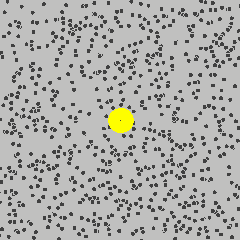Fixation (visual)
Fixation (visual) refers to the process by which the eye maintains focus on a single point in the visual field. This is a crucial aspect of visual perception and is essential for activities such as reading, driving, and any task that requires detailed visual attention.
Mechanism[edit | edit source]
Fixation involves the coordination of several ocular muscles to keep the fovea, the central part of the retina responsible for sharp vision, aligned with the target. The brain plays a significant role in this process, integrating sensory information and controlling the extraocular muscles to maintain steady gaze.
Types of Fixation[edit | edit source]
There are several types of fixation:
- Steady fixation: The eye remains stationary on a single point.
- Saccadic fixation: Rapid movements of the eye between points of interest.
- Smooth pursuit: The eye smoothly follows a moving object.
Clinical Significance[edit | edit source]
Proper fixation is essential for clear vision. Disorders of fixation can lead to visual impairment and are often associated with conditions such as strabismus, nystagmus, and amblyopia. Ophthalmologists and optometrists assess fixation as part of a comprehensive eye examination.
Assessment[edit | edit source]
Fixation can be assessed using various techniques:
- Direct observation: Clinicians observe the patient's ability to maintain focus on a target.
- Eye tracking devices: These devices measure the precise movements of the eye to evaluate fixation stability.
Related Concepts[edit | edit source]
See Also[edit | edit source]
References[edit | edit source]
External Links[edit | edit source]
Search WikiMD
Ad.Tired of being Overweight? Try W8MD's physician weight loss program.
Semaglutide (Ozempic / Wegovy and Tirzepatide (Mounjaro / Zepbound) available.
Advertise on WikiMD
|
WikiMD's Wellness Encyclopedia |
| Let Food Be Thy Medicine Medicine Thy Food - Hippocrates |
Translate this page: - East Asian
中文,
日本,
한국어,
South Asian
हिन्दी,
தமிழ்,
తెలుగు,
Urdu,
ಕನ್ನಡ,
Southeast Asian
Indonesian,
Vietnamese,
Thai,
မြန်မာဘာသာ,
বাংলা
European
español,
Deutsch,
français,
Greek,
português do Brasil,
polski,
română,
русский,
Nederlands,
norsk,
svenska,
suomi,
Italian
Middle Eastern & African
عربى,
Turkish,
Persian,
Hebrew,
Afrikaans,
isiZulu,
Kiswahili,
Other
Bulgarian,
Hungarian,
Czech,
Swedish,
മലയാളം,
मराठी,
ਪੰਜਾਬੀ,
ગુજરાતી,
Portuguese,
Ukrainian
Medical Disclaimer: WikiMD is not a substitute for professional medical advice. The information on WikiMD is provided as an information resource only, may be incorrect, outdated or misleading, and is not to be used or relied on for any diagnostic or treatment purposes. Please consult your health care provider before making any healthcare decisions or for guidance about a specific medical condition. WikiMD expressly disclaims responsibility, and shall have no liability, for any damages, loss, injury, or liability whatsoever suffered as a result of your reliance on the information contained in this site. By visiting this site you agree to the foregoing terms and conditions, which may from time to time be changed or supplemented by WikiMD. If you do not agree to the foregoing terms and conditions, you should not enter or use this site. See full disclaimer.
Credits:Most images are courtesy of Wikimedia commons, and templates, categories Wikipedia, licensed under CC BY SA or similar.
Contributors: Prab R. Tumpati, MD



